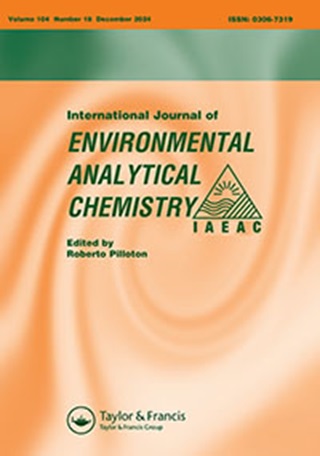污水处理厂污泥中的重金属:一种评估重金属来源和对土地利用风险的工具
IF 2.5
4区 化学
Q3 CHEMISTRY, ANALYTICAL
International Journal of Environmental Analytical Chemistry
Pub Date : 2023-10-30
DOI:10.1080/03067319.2023.2271425
引用次数: 1
摘要
摘要本研究的目的是根据污水污泥的总组分和化学组分评价重金属浓度,识别重金属来源,评价生态风险。从孟加拉国达卡市六种不同类型的污水处理厂网络中收集了36个厌氧混合污泥样本。采用酸消化后的电感耦合等离子体质谱仪分析了污泥样品中重金属的总浓度和分数浓度。污泥中铬(Cr)、镍(Ni)、铜(Cu)、砷(As)、镉(Cd)、铅(Pb)、铁(Fe)、锰(Mn)和锌(Zn)的平均含量范围分别为237.3 ~ 381.8、108.5 ~ 220.2、116.1 ~ 207.2、14.9 ~ 56.1、0.68 ~ 2.86、72.4 ~ 172.0、12055 ~ 20115、64.8 ~ 170.6和117.5 ~ 178.5 mg/kg。地球化学形态数据表明,残余部分以Fe、Zn、Ni、Cu和Mn为主,交换部分以As、Cd和Pb为主,说明As、Cd和Pb对周边生态系统的危害程度较高。研究结果显示,重金属对生态环境构成中度至相当大的风险。人为活动包括工业废物和农业化学品是研究区STP网络污泥中重金属的主要来源。在孟加拉国采集的样品经横滨植物保护站许可进入日本(进口许可证号:25Y324和25Y1009)。作者感谢孟加拉国Dumki, Patuakhali-8602的Patuakhali科技大学(PSTU)对样品处理和日本东京大学对样品分析的权威。此外,我们感谢孟加拉国达卡大学成员在实地抽样期间提供的热心帮助。披露声明作者未报告潜在的利益冲突。补充数据本文的补充数据可在线访问https://doi.org/10.1080/03067319.2023.2271425.Additional informationfunding作者感谢国王哈立德大学的科学研究主任通过批准号(R.G.P.2/326/44)的大型团体研究项目资助这项工作。本文章由计算机程序翻译,如有差异,请以英文原文为准。
Heavy metals in sludge from the sewage treatment plant network: a tool to evaluate source and risks of heavy metals to land application
ABSTRACTThe aim of the study was to evaluate heavy metals concentration based on the total and chemical fractions of sewage sludge, to identify the sources of heavy metals and to assess ecological risks. Thirty-six anaerobic mixed sludge samples were collected from six different types of sewage treatment plant network in Dhaka city, Bangladesh. Total and fraction concentration of heavy metals in sludge samples were analysed by inductively coupled plasma mass spectrometer following acid digestion. The mean ranges of chromium (Cr), nickel (Ni), copper (Cu), arsenic (As), cadmium (Cd), lead (Pb), iron (Fe), manganese (Mn) and zinc (Zn) in the sludges were 237.3–381.8, 108.5–220.2, 116.1–207.2, 14.9–56.1, 0.68–2.86, 72.4–172.0, 12055 –20,015, 64.8–170.6 and 117.5–178.5 mg/kg, respectively. The data of geochemical speciation showed that Fe, Zn, Ni, Cu and Mn were associated with the residual fraction, whereas As, Cd and Pb showed predominant proportion in the exchangeable fraction, indicating the severity of risk by As, Cd and Pb to the surrounding ecosystem. The findings of the study revealed that heavy metals posed moderate to considerable ecological risk. Anthropogenic activities including industrial wastes and agricultural chemicals are substantial sources for heavy metals in the sludge of STP network in the study area.KEYWORDS: Bangladeshheavy metalssequential extractionsludgeSTP network AcknowledgmentsThe samples collected in Bangladesh were brought into Japan based on the permission issued by the Yokohama Plant Protection Station (Import permit No. 25Y324 and 25Y1009). The authors are thankful to the authority of Patuakhali Science and Technology University (PSTU), Dumki, Patuakhali-8602, Bangladesh for sample processing and The University of Tokyo, Japan, for sample analysis. Furthermore, we are thankful for the kind help from the members of Dhaka University, Bangladesh, during the field sampling.Disclosure statementNo potential conflict of interest was reported by the author(s).Supplementary dataSupplemental data for this article can be accessed online at https://doi.org/10.1080/03067319.2023.2271425.Additional informationFundingThe authors extend their appreciation to the Deanship of Scientific Research at King Khalid University for funding this work through Large Group Research Project under grant number (R.G.P.2/326/44).
求助全文
通过发布文献求助,成功后即可免费获取论文全文。
去求助
来源期刊
CiteScore
5.90
自引率
7.70%
发文量
373
审稿时长
4.4 months
期刊介绍:
International Journal of Environmental Analytical Chemistry comprises original research on all aspects of analytical work related to environmental problems. This includes analysis of organic, inorganic and radioactive pollutants in air, water, sediments and biota; and determination of harmful substances, including analytical methods for the investigation of chemical or metabolic breakdown patterns in the environment and in biological samples.
The journal also covers the development of new analytical methods or improvement of existing ones useful for the control and investigation of pollutants or trace amounts of naturally occurring active chemicals in all environmental compartments. Development, modification and automation of instruments and techniques with potential in environment sciences are also part of the journal.
Case studies are also considered, particularly for areas where information is scarce or lacking, providing that reported data is significant and representative, either spatially or temporally, and quality assured. Owing to the interdisciplinary nature of this journal, it will also include topics of interest to researchers in the fields of medical science (health sciences), toxicology, forensic sciences, oceanography, food sciences, biological sciences and other fields that, in one way or another, contribute to the knowledge of our environment and have to make use of analytical chemistry for this purpose.

 求助内容:
求助内容: 应助结果提醒方式:
应助结果提醒方式:


